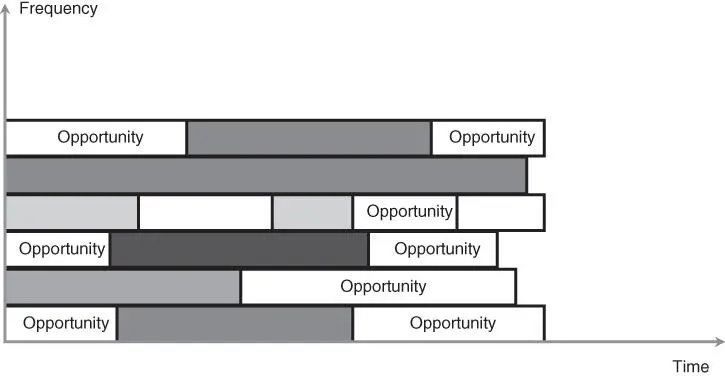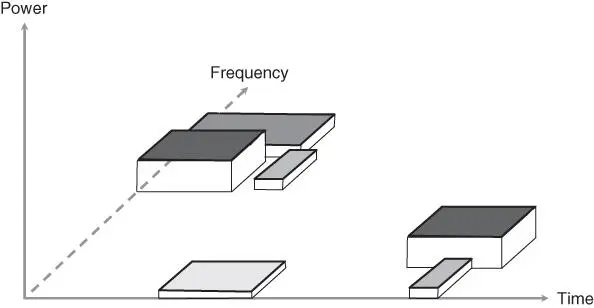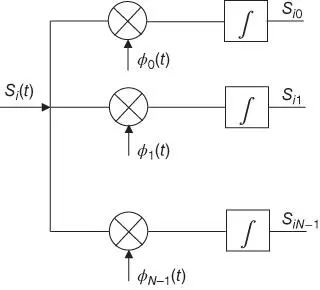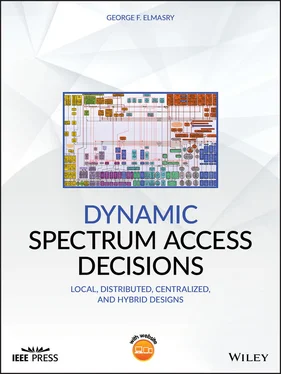Although energy detection is the most common spectrum sensing technique, time, frequency, and power spectrum sensing are covered first in this chapter to emphasize the multidimensional aspects of spectrum sensing. The idea behind this spectrum sensing technique is to create multidimensional spectrum awareness. The simplest form of this spectrum sensing technique is a two‐dimensional spectrum sensing that uses the frequency and time dimensions. Figure 2.2shows this two‐dimensional spectrum sensing where the spectrum sensor looks for occupancy of certain frequency bands at certain times.

Figure 2.2Two‐dimensional spectrum sensing.
A secondary user can use this spectrum sensing technique where it can hop to a different frequency band once it detects another user on a frequency it is using. This technique does not consider the signal power and relies on DSA defining a cutoff RSSI level to consider a frequency band as occupied or can be opportunistically used. The cutoff RSSI level may also be an estimation of additive white Gaussian noise (AWGN) without the presence of any signal.
If a communications system is to consider underlay or overlay transmission, the two‐dimensional spectrum sensing in Figure 2.2can be turned into three‐dimensional spectrum sensing as shown in Figure 2.3. In this case, the power dimension is added. In Figure 2.3, the unoccupied areas are often referred to as spectrum holes or white spaces .

Figure 2.3Three‐Dimensional spectrum sensing.
Notice that more dimensions can be added to this multidimensional spectrum sensing technique. For example, the spreading code can be sensed and made a fourth dimension. Spreading code sensing can show opportunistic transmission based on using specific spreading codes. Spectrum sensing of spreading code is covered in Section 2.3.3as a signal characteristic.
2.3 Energy Detection Sensing
This is the most common spectrum sensing approach used today. As explained in Chapter 3, the receiver's operator characteristic (ROC) function makes good use of this simple energy detection approach. Chapter 3 covers how same‐channel in‐band sensing can use energy detection sensing with minimal requirements on the receiver to hypothesize the presence of interference.
RSSI is a common expression of energy detection. RSSI is so common that you can look at your phone while having wireless fidelity (WiFi) 3connectivity and count the WiFi connectivity indicator lines on the top of your screen to see how RSSI is commonly mapped to about four levels (no connectivity, low connectivity, medium connectivity, and good connectivity). Laptop WiFi connectivity indicators typically map the WiFi RSSI to five or six levels. Other devices illustrate RSSI in more or less this number of levels.
A simple receiver can collect the energy received on the antenna in a certain frequency band and quantize it. Low computational complexity and simple implementation are what makes energy detection commonly used. In Figure 2.3, energy detection below a certain power threshold constitutes an opportunity for a spectrum band use (e.g., by a secondary user 4). On the other hand, energy detection above that threshold constitutes an occupied band. In Figure 2.3, energy detection is the power axis. Deciding the value of that cutoff threshold can be challenging as the primary user signal may suffer from interference, multipath fading, and jamming among other factors that can affect the signal strength. Energy detection becomes especially more challenging when sensing spread spectrum signals that tend to have low energy. Chapter 3 is dedicated to DSA decision making and will discuss how cutoff thresholds can be used.
2.3.1 Energy Detection Sensing of a Communications Signal (Same‐channel in‐band Sensing)
Let us start from the unit of energy of a communications signal Φ j( t ), which can be defined as follows: If the receiver detects a 1 V signal across a 1 Ω resistor, the integration of the square value of signal voltage over a specific time period ( T g, T f) is 1, that is, the receiver has detected one unit of energy. 5Notice the following:
1 The signal can be constructed in a multidimensional signal‐in‐space (SiS) as a vector. 6
2 The time T = Tf − Tg is a critical factor in detecting the signal energy. 7If the signal is too weak, the integration of the square value of the signal voltage may need a long period of time to yield reliable energy detection.
The receiver of a communications signal detects a multicoefficient signal in N ‐dimensional SiS and attempts to match the received signal with one of M signals. 8The energy detector cares only for the signal energy not the signal decoding.
The signal's i th dimension projected on the k th base can be expressed as follows:
(2.1) 
where Φ k( t ) is the signal basis per coefficient.
Notice that both the signal receiver and the spectrum sensor performing energy detection need to carry similar steps to calculate the received signal energy. Chapter 3 covers how to use same‐channel in‐band sensing to hypothesize the presence of an interfering signal. This section is intended to show how to piggyback on the communications receiver's energy calculation to create same‐channel in‐band energy sensing.
Figure 2.4shows how a communications receiver recovers a signal S i( t ) based on knowing its base per each dimension. The projection of the signal per each dimension is expressed in Equation (2.1). The baseband signal S i( t ) is then mapped to a point in the N ‐dimensional SiS. The square distance from the origin to the projected point from Figure 2.4,  , is simply the received signal energy. While the communications receiver takes further steps to decode the projected signal based on the squared intra‐signal distances, an outcome of the communications signal receiver,
, is simply the received signal energy. While the communications receiver takes further steps to decode the projected signal based on the squared intra‐signal distances, an outcome of the communications signal receiver,  , is energy detection that can be utilized for same‐channel in‐band sensing. Calculating
, is energy detection that can be utilized for same‐channel in‐band sensing. Calculating  is the common process between signal decoding and signal energy detection. As will become clear in Chapter 3, the purpose of same‐channel in‐band sensing is to decide if the communications signal utilized frequency band suffers from an interference level that requires using a different frequency band or if the interference level is tolerable.
is the common process between signal decoding and signal energy detection. As will become clear in Chapter 3, the purpose of same‐channel in‐band sensing is to decide if the communications signal utilized frequency band suffers from an interference level that requires using a different frequency band or if the interference level is tolerable.

Figure 2.4Leveraging signal receiver reconstruction of the received signal for same‐channel in‐band spectrum sensing.
A communication receiver also calculates SNIR. The SNIR calculation is based on the energy detection of the signal and the energy detection of the noise (known as the noise floor). Signal energy detection and noise floor energy detection are metrics that can be leveraged for same‐channel in‐band spectrum sensing because they are common between signal decoding and same‐channel in‐band sensing. The value of using SNIR in same‐channel in‐band sensing will become clear in Chapter 3.
Читать дальше




 , is simply the received signal energy. While the communications receiver takes further steps to decode the projected signal based on the squared intra‐signal distances, an outcome of the communications signal receiver,
, is simply the received signal energy. While the communications receiver takes further steps to decode the projected signal based on the squared intra‐signal distances, an outcome of the communications signal receiver,  , is energy detection that can be utilized for same‐channel in‐band sensing. Calculating
, is energy detection that can be utilized for same‐channel in‐band sensing. Calculating  is the common process between signal decoding and signal energy detection. As will become clear in Chapter 3, the purpose of same‐channel in‐band sensing is to decide if the communications signal utilized frequency band suffers from an interference level that requires using a different frequency band or if the interference level is tolerable.
is the common process between signal decoding and signal energy detection. As will become clear in Chapter 3, the purpose of same‐channel in‐band sensing is to decide if the communications signal utilized frequency band suffers from an interference level that requires using a different frequency band or if the interference level is tolerable.











